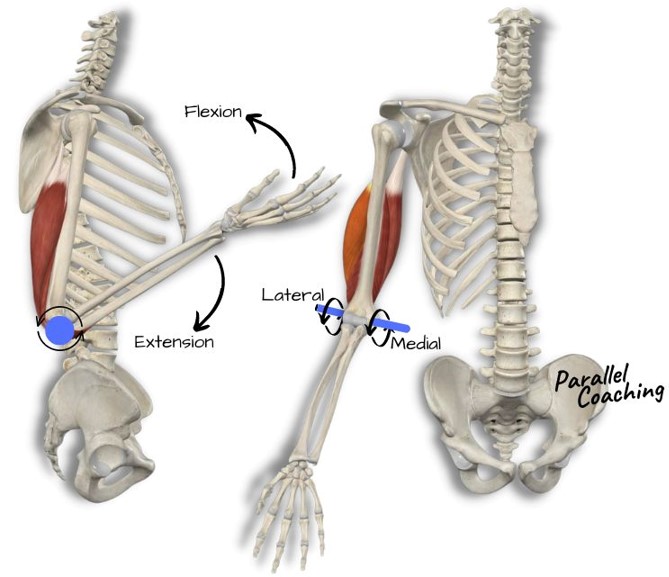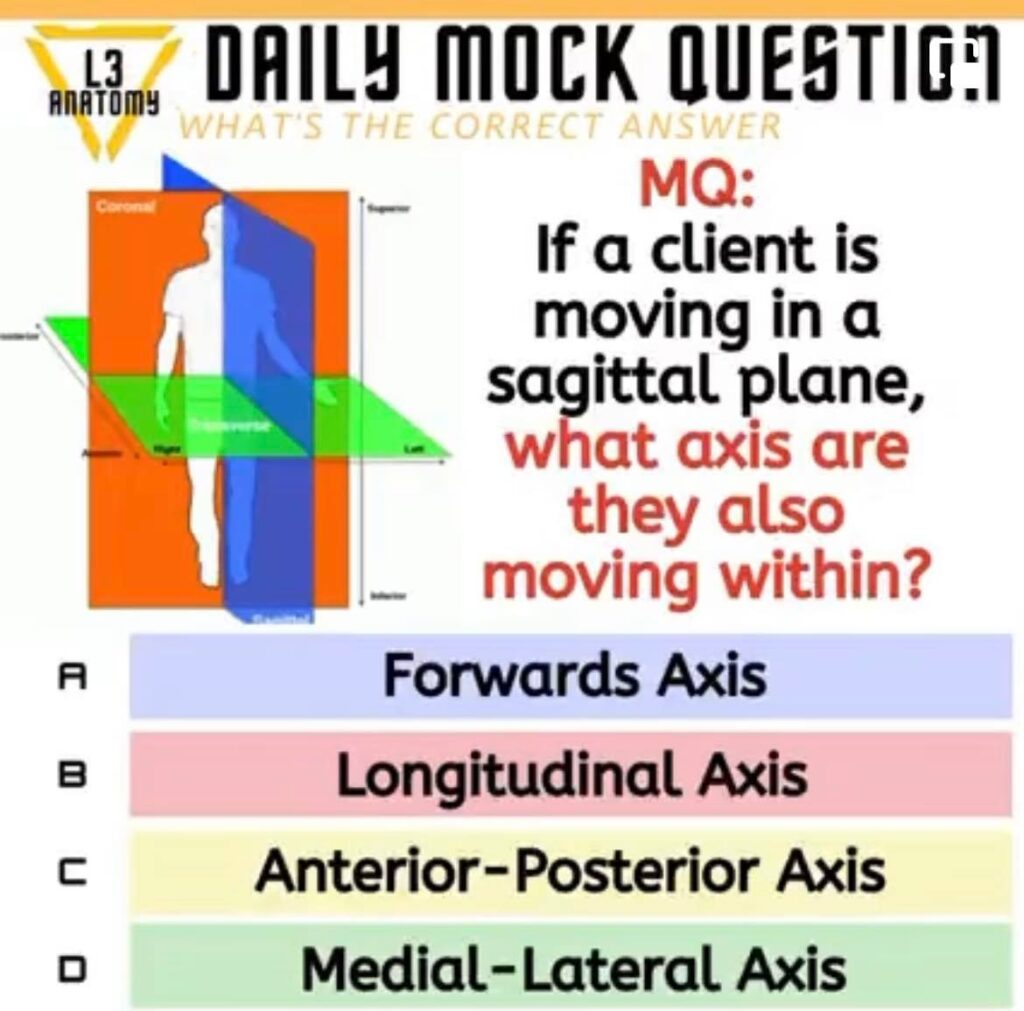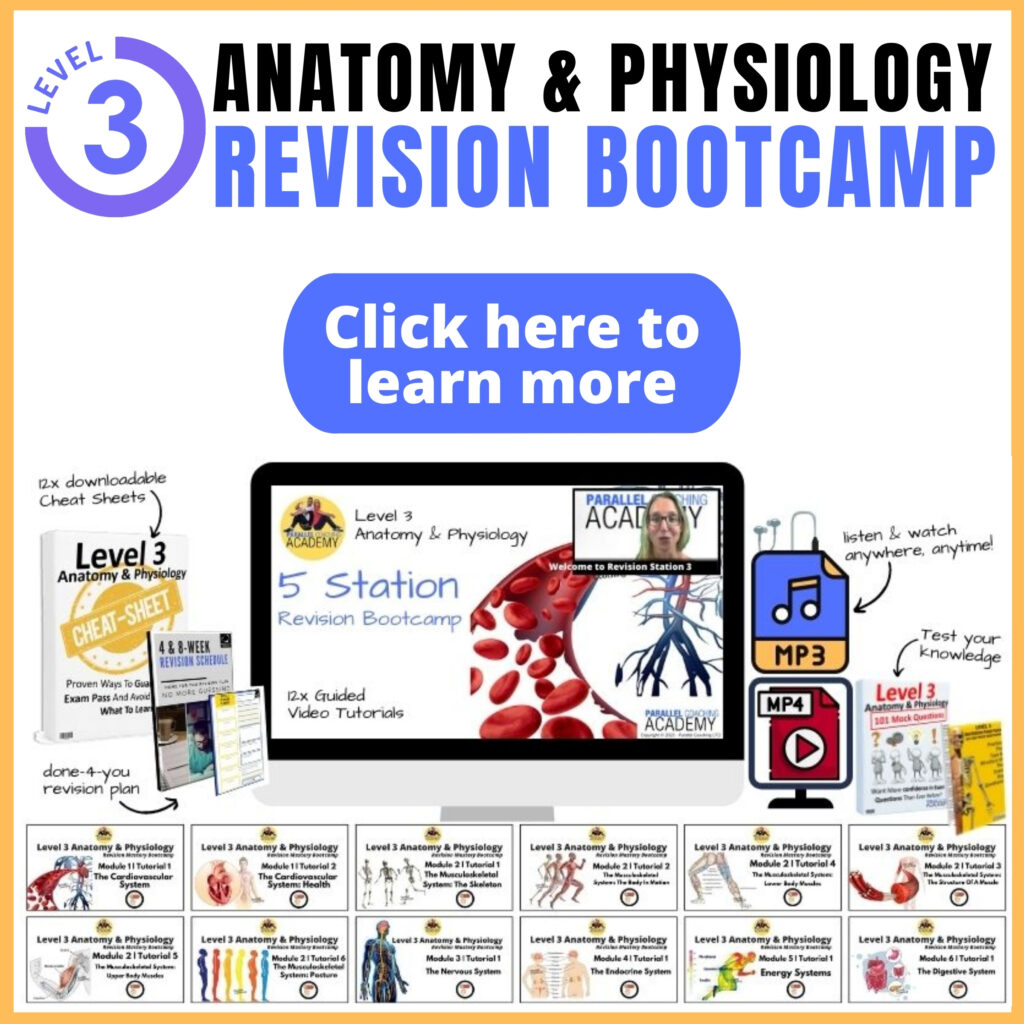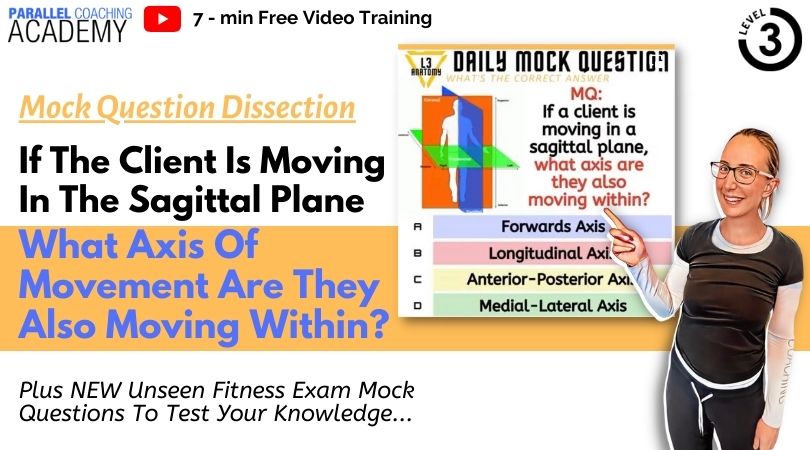This week’s edition of “mock question dissection” explores and answers the question… “If The Client Is Moving In The Sagittal Plane What Axis Of Movement Are They Also Moving Within?”
You’ll discover:
- 7-minute video tutorial explaining and answering today’s mock question.
- Why Learning Planes and axis of movement is difficult?
- What are the three planes of movement?
- Understanding Joint actions are key
- The link between Planes and axis of movement
- The answer to “If The Client Is Moving In The Sagittal Plane What Axis Of Movement Are They Also Moving Within?”
- More mock questions to test your knowledge
- How to learn and remember complex anatomy
Watch Mock Question Dissection…
If The Client Is Moving In The Sagittal Plane What Axis Of Movement Are They Also Moving Within?
Why Learning Planes and axis of Movement is difficult?
The Body In Motion is notoriously claimed to be one of the hardest modules within the Level 3 Anatomy and Physiology syllabus. You are not alone if you find this area difficult to understand.
If you are learning via reading, then the 2-dimensional images make it hard to understand 3-dimensional movement.
You might not be quoting the plane or axis of movement with your clients. However, the knowledge of this, allows you to understand movement mechanics.
This will improve your ability to plan sessions for your client and encourage your client to move efficiently.
What Is The Difference Between Planes of Movement and Axis of Movement
What are the three planes of movement?
We have three planes of movement:
Sagittal Plane: This includes forward and backward movements. It includes the joint actions of flexion and extension, dorsiflexion and plantarflexion.
Frontal Plane: This includes side-to-side movements like adduction, abduction and Lateral flexion
Transverse Plane: This includes rotation movements like pronation, supination, internal and external rotation.
Understanding Joint Actions are key
The key to understanding Planes of Movement is to learn the Joint Actions. The classification of planes of movement relates to individual actions at a joint NOT the exercises.
Rather than saying an Ab Crunch is in the Sagittal Plane. It helps clarity of understanding to say that Spinal flexion (found in an ab crunch) occurs in the sagittal plane.
For today’s mock question dissection, we are discussing the Sagittal Plane. The Sagittal Plane is only concerned with the following joint actions:
- flexion
- extension
- plantarflexion
- dorsiflexion
These can be of any joint that allows for that movement. So flexion could be the shoulder, elbow, spine, hip, knee etc…
Any flexion action is in the sagittal plane
The link between Planes and Axis of movement
The Axis of Movement is the invisible straight line that our joints move around.
We also have three of these:
Medial-Lateral Axis: This is where the invisible straight line goes from side to side. This is the medial edge to the lateral edge of the joint.
Anterior-Posterior Axis: This is where the invisible straight line goes front to back. This is the anterior surface to the posterior surface of the joint.
Longitudinal Axis: This is where the invisible straight line goes top to bottom, so down the length of the joint.

What Is The Difference Between Planes of Movement and Axis of Movement
Planes of Movement and Axis of Movement relate to each other
READ THE FOLLOWING VERY CAREFULLY AND TAKE NOTE.
- Sagittal Plane movements occur around a Medial-Lateral Axis
- Frontal Plane movements occur around an Anterior-Posterior Axis
- Transverse Plane Movements occur around a longitudinal Axis.
The answer to “If The Client Is Moving In The Sagittal Plane What Axis Of Movement Are They Also Moving Within?”
Today’s mock question is:

As explained above the answer is D: Medial – Lateral Axis.
Test your knowledge with today’s body-in-motion mock questions:
[NOTE: The answers are below the 3rd question]
Q1: Joint extension occurs around what axis of movement?
A. Frontal B. Anterior-Posterior C. Sagittal D. Medial-Lateral
Q2: All movements that move around a medial-lateral axis of movement, occur in which plane of movement?
A. Transverse B. Frontal C. Sagittal D. Latitudinal
Q3: Which plane of movement is a client moving in during a frontal raise exercise (shoulder flexion)?
A. Longitudinal B. Anterior-Posterior C. Medial-Lateral D. Sagittal
Answers to the mock questions are :
Question 1= D, Question 2 = C, Question 3 = D
If you want more mock questions like this, then you can download more Free Mock Questions: DOWNLOAD NOW
Need More Help with your Level 3 Anatomy Revision?
For Trainee FITPROS Taking Their L3 Anatomy & Physiology Exam.
Learn, Revise & Pass Your Level 3 Anatomy & Physiology Exam In Under 10-hours
(Without Having To Spend Hours Revising Or Feeling Overwhelmed)
If you want to get your revision structured, learn everything you need to know and feel confident on exam day, then click the link below:

Dedicated to More
Hayley “If The Client Is Moving In The Sagittal Plane What Axis Of Movement Are They Also Moving Within?” Bergman
Parallel Coaching
P.S. You can also find us on the following platforms:
Instagram: Follow Now
Facebook: Like Our Page
Twitter: Tweet Us
YouTube: Subscribe Here
More Mock Question Blogs: HERE
KINGS Formula training HERE

